Federal University of Paraná
The Federal University of Paraná[1] (Portuguese: Universidade Federal do Paraná, UFPR) is a public university headquartered in Curitiba, Paraná, Brazil.[2] UFPR is considered to be one of the oldest universities in Brazil.[3]
Universidade Federal do Paraná | |
 | |
Other names | UFPR |
|---|---|
Former names | Universidade do Paraná |
| Motto | Scientia et Labor |
Motto in English | Science and Work |
| Type | Public (federal) |
| Established | 1912 |
| Budget | R$ 1,038,070,033.68 (2013) |
| Rector | Ricardo Marcelo Fonseca |
Academic staff | 2,328 |
Administrative staff | 3,759 |
| Undergraduates | 28,048 |
| Postgraduates | 8,658 |
| Location | , Brazil |
| Campus | Curitiba, Matinhos, Palotina, Pontal do Paraná and Jandaia do Sul |
| Website | www |
UFPR ranks as 37th best university in Latin-America and it is among the 651-700 best universities in the world, according to QS World University Rankings. It is placed as the eighth best university in Brazil in the latest "Ranking Universitário Folha (RUF)", published by the nation's largest newspaper.
Nowadays, its facilities are spread over the capital Curitiba and other cities of the State of Paraná. It offers 124 undergraduate degree courses,[4] 44 doctorate, 66 masters and 5 professional masters programs,[5] apart from a number of lato sensu programs (mostly paid one-year specializations) - see Higher-ed degrees in Brazil.
History
In 1892, José Francisco da Rocha Pombo, an intellectual of the state of Paraná would have initiated the construction of the university, but his project was frustrated by the Federalist Movement.
Twenty years later, Paraná had a reduced number of intellectuals (nine doctors and four engineers), but it was in true development because of the production of the yerba mate.
Moreover, at this time, the Contestado War appeared as an incentive to the efforts of political leaderships concerning the creation of a university. In this context, Victor Ferreira do Amaral, deputy and director of public instruction of Paraná, started the effective creation of the university.
On December 19, 1912, the university was established and, in 1913, it has initiated its activities as a private institution in an old building situated on Comendador Araújo street. The first courses offered were Juridical and Social Sciences, Engineering, Medicine and Surgery, Commerce, Dentistry, Pharmacy and Obstetrics. After the establishment of the university, Victor Ferreira do Amaral, who was also its first president, initiated the construction of a central building in a land donated by the municipal government.
Due to the economic recession caused by the World War I, difficulties started to appear. In 1920, a federal law determined the closing of all universities. In a contradictory measure, the federal government created the Universidade do Rio de Janeiro, currently Universidade Federal do Rio de Janeiro (Federal University of Rio de Janeiro). The alternative to this law was to split the UFPR in several colleges.
Throughout several years, efforts in order to restore the university took place. Only in the beginning of the fifties the colleges were reunited once again in the University of Paraná, its federalization happening just after that, in 1951, when the university became a public and free-of-charge institution.
After its federalization, a process of expansion began with the construction of the Clinic's Hospital (Portuguese: Hospital de Clínicas da Universidade Federal do Paraná) in 1953, the Reitoria Campus in 1958 and the Polytechnic Center in 1961. The Polytechnic Center campus occupies 617,128 square metres (6,642,710 sq ft).[2]
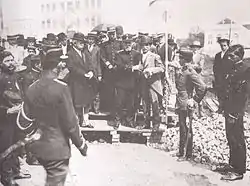
Historical Building
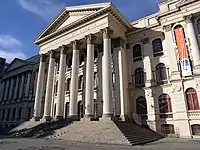
The construction placed in the Santos Andrade Square began to be built in 1913, being a project of the military engineer Baeta de Faria. Its inauguration occurred in 1915.
Seven years later, in 1923, two lateral parts were added, according to the original project. The building of the right sector was ended in 1925 and was designated to the Engineering graduation course. In the following year, the left sector had been finalized and it passed to serve the Dentistry course. Other additions were made to the right side of the building and it has received in its totality new paint in 1940. The building was extended towards XV de Novembro Street and, in 1952, new works in the right section led to the demolition of part of the lateral façade built in 1940.
In 1954, the building occupied a whole block between the Santos Andrade Square, XV de Novembro Street, Presidente Faria Street and Alfredo Bufren Lane. The last modifications were made: a new façade with several columns and a wide set of staircases were projected and the covered dome was eliminated. The inauguration of the neoclassical, 17,000 square meter building, took place in 1955.
In the year on 1999, the mayor of Curitiba signed a law that made this building the official symbol of the city.
Academics
Undergraduate programs
|
|
|
Master Programs
- Physical Education
- Pharmacology
- Biochemistry
- Genetics
- Zoology
- Botany
- Child and Teenager Health
- Pharmaceutical Sciences
- Surgery
- Internal Medicine and Health Sciences
- Nursery
- Geodesic Sciences
- Geology
- Geography
- Coastal and Oceanic Systems
- Environmental Development
- Applied Mathematics
- Information Systems
- Chemistry
- Physics
- Education
- Anthropology
- Sociology
- History
- Philosophy
- Psychology
- Languages and Literature
- Design
- Music
- Economical Development
- Business Administration
- Accounting and Finance
- Law
- Numerical Methods for Engineering
- Water Resources and Environmental Engineering
- Biotechnological Process
- Food Engineering
- Inter-disciplinary Themes on Engineering
- Electrical Engineering
- Civil Engineering
- Mechanical Engineering
- Chemical Engineering
- Political Sciences
- Bioinformatics
- Teaching of Environmental Science
Doctoral programs
|
|
Admissions
Students are admitted by an entrance exam, known as the vestibular, which consists of two parts:
- Part I is composed of 80 multiple-choice questions including nine questions of each of the following subjects: Portuguese, Literature, Chemistry, Mathematics, Physics, Geography, History and Biology, plus eight questions of a foreign language which can be chosen from English, French, Spanish, German or Italian.
Over 50,000 people apply every year and sit for exactly the same exam. After two weeks time or so, 15,000 are called to take the Part II (or Phase II) written exams.
- Part II is composed of a Portuguese test which covers five (previously seven) compulsory writing essays. Certain courses require that the candidate take an additional one or two exams involving open-questions in Chemistry, Mathematics, Physics, Geography, History, Biology, Philosophy or Sociology, the specific exam choice being determined by correlation between the subject and each major course. Engineering candidates, for example, take Mathematics and Physics tests.
The wait for the results of Part II is much longer and the results may take something between 4 and 7 weeks. A list with all the admitted candidates comes out usually in the middle of January—on the same day as the Mud-bath Party sponsored by the Central Directory of Students (Portuguese: Diretório Central dos Estudantes, DCE) occurs.
Laboratories
- Centro de Documentação e Pesquisa de História dos Domínios Portugueses – CEDOPE
- Centro de Capacitação e Consultoria do Departamento de Ciência e Gestão da Informação do Setor de Ciências Sociais Applicadas – 3CGI
- Centro de Ciência de Segurança Computacional - CCSC
- Centro de Computação Científica e Software Livre – C3SL
- Centro de Estudos do Mar - CEM
- Centro de Microscopia Eletrônica – CME
- Centro de Pesquisa e Processamento de Alimentos – CEPPA
- Ciências Sociais Applicadas – CCCGI
- Centro de Estudos de Engenharia Civil Prof. inaldo Ayres Vieira – CESEC
- Grupo IMAGO de Pesquisa em Visão Computacional, Processamento de Imagens e Computação Gráfica
- Instituto de Tecnologia para o Desenvolvimento – LACTEC
- Laboratório de Análises Clínicas veterinárias
- Laboratório de Acústica e conforto Ambiental
- Laboratório de Eletroquímica de Superfícies e Corrosão – LESC
- Laboratório de Estudos em Monitoramento e Modelagem Ambiental – LEMMA
- Laboratório de Ictiologia Estuarina - Ictiologia UFPR
- Laboratório de Inventário Florestal
- Laboratório de Minerais e Rochas – LAMIR
- Laboratório de Nutrição Animal do Departamento de Zootecnia
- Laboratório de Paisagismo
- Laboratório de Parasitologia Clínica Veterinária - LPCV
- Laboratório de Pesquisas Hidrogeológicas – LPH
- Laboratório de Proteção Florestal
- Laboratório de Matriz Extracelular e Biotecnologia de Venenos
- Laboratório de Neurobiologia
- Laboratório de Citogenética Humana
- Laboratório de Genética Molecular Humana – LGMH
- Laboratório de Metabolismo Celular
- Laboratório de Imunogenética e Histocompatibilidade
- Laboratório de Óptica de Raios-X e Instrumentação – LORXI
- Laboratório de Superfícies e Interfaces – LSI
- Laboratório de Genética de Microorganismos – LabGeM
- Laboratório de Bioquimíca e Biofísica de Macromoléculas
- Laboratório de Anestesia e Analgesia Veterinária - LABEST
- Núcleo de Fixação de Nitrogênio - NFIX
- Núcleo de Redes sem Fio e Redes Avançadas - NR2
And many more
Libraries
The university has over 400,000 books and theses as well as thousand of periodicals that, for now, can't be accessed through its intranet, but will be in the future.
|
Juvevê Centro
Centro Politécnico
|
Jardim Botânico
Matinhos
Paranaguá
Pontal do Paraná
|
Campi
- In Curitiba
- Campus Juvevê
- Campus Batel
- Campus Centro
- Campus Reitoria
- Campus Ciências Agrárias/Cabral
- Campus III/Centro Politécnico
- Campus III/Escola Técnica
- Campus III/Jardim Botânico
- Other cities
- Campus Palotina – Palotina
- Campus Estudos do Mar – Pontal do Paraná
- Campus Litoral – Matinhos
- Campus Jandaia do Sul – Jandaia do Sul
Publications
- Archives of Veterinary Science
- Acta Biologica Paranaense
- Boletim Paranaense de Geociências
- Educar em Revista
- Jornal de Ciências do Exercício e do Esporte
- Jornal do Hospital das Clínicas
- Revista de Ciências Humanas
- Revista de Sociologia e Política
- Revista do Departamento e Programa de Pós-Graduação
- Revista Eletrônica de Musicologia
- Revista Floresta
- Revista Interação
- Revista Letras
- Scientia Agraria
- Revista de Engenharia Térmica
Notable alumni
- Blairo Maggi — agrobusiness entrepreneur
- Clèmerson Merlin Clève — jurist, lawyer, and entrepreneur
- Dalton Trevisan — writer, Camões Prize winner
- Daniel Przybysz — radiation oncologist
- Edson Fachin — jurist, lawyer
- Edith Fanta — Antarctic researcher
- Enedina Alves Marques — civil engineer, first Black woman to receive an engineering degree in Brazil
- Henry Bugalho — philosopher and writer
- Jaime Lerner — governor of Paraná (1995-2002)
- Jorge Reis-Filho — scientist
- Laurentino Gomes — writer and journalist, Jabuti Prize winner
- Marçal Justen Filho — jurist, lawyer
- Newton da Costa — logician and mathematician
- Roberto Requião — governor of Paraná (2003-2010) and senator since 2011
- Tirone E. David — medical doctor
- Wilson Martins — politician (Governor of Piauí from April 1, 2010, to April 2, 2014.)
- Notable UFPR Alumni
 Laurentino Gomes, writer
Laurentino Gomes, writer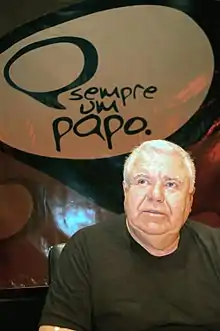 Jaime Lerner, former governor of Paraná
Jaime Lerner, former governor of Paraná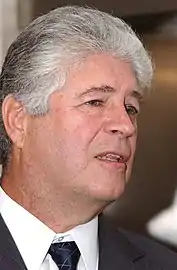 Roberto Requião, senator and former governor of Paraná
Roberto Requião, senator and former governor of Paraná.jpg.webp) Luiz Edson Fachin, incumbent minister of the Supreme Court of Brazil
Luiz Edson Fachin, incumbent minister of the Supreme Court of Brazil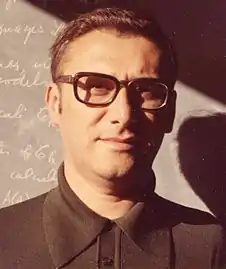 Newton da Costa, logician and mathematician
Newton da Costa, logician and mathematician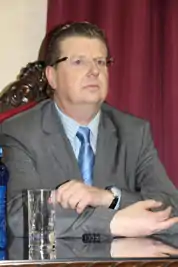 Clèmerson Merlin Clève, jurist, lawyer, and entrepreneur
Clèmerson Merlin Clève, jurist, lawyer, and entrepreneur
See also
References
- "TaxOn-Line UFPR". Archived from the original on October 24, 2007. Retrieved August 18, 2008.
- Trombetta Zannin, Paulo Henrique; Engel, Margret Sibylle; Kirrian Fiedler, Paulo Eduardo; Bunn, Fernando (2013). "Characterization of environmental noise based on noise measurements, noise mapping and interviews: A case study at a university campus in Brazil". Cities. Elsevier. 31: 317–327. doi:10.1016/j.cities.2012.09.008.
- "A mais antiga do Brasil". UFPR Official Website. Retrieved March 7, 2021.
- 2013/2014 Candidate's guide
- "Programas de Mestrado e Doutorado - PRPPG - Pró-Reitoria de Pesquisa e Pós-Graduação - UFPR". Archived from the original on August 19, 2015. Retrieved July 5, 2015.
Further reading
External links
- Official website
 (in Portuguese)
(in Portuguese)